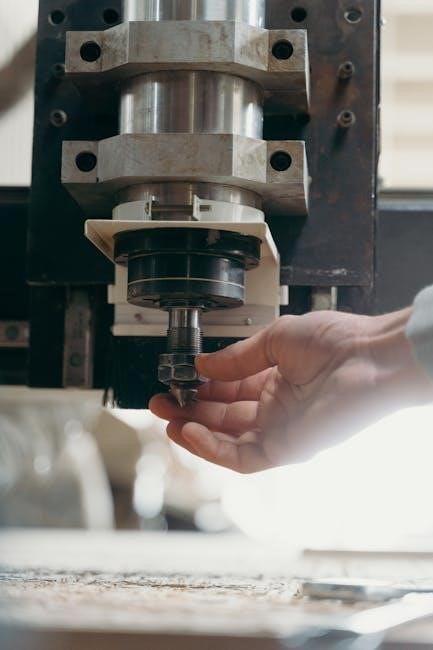Manual vending machines are hand-operated devices that dispense products without electricity, offering a cost-effective, mechanically simple solution for small businesses and public spaces. They are reliable, easy to install, and require minimal maintenance, making them a practical choice for various applications.
Overview of Manual Vending Machines
Manual vending machines are simple, non-electronic devices designed to dispense products such as snacks, beverages, or other small items. They operate using mechanical components like levers, dials, or coin slots, requiring manual interaction from users. These machines are cost-effective, easy to install, and suitable for low-traffic areas like small retail stores or public facilities. Unlike automated versions, they rely on mechanical processes rather than electronic systems, making them reliable and low-maintenance. Their straightforward design ensures ease of use, with users typically depositing coins or turning a handle to receive their selected item. This simplicity makes manual vending machines a practical choice for businesses seeking affordable solutions.
Importance of Manual Vending Machines
Manual vending machines hold significant value in various settings due to their simplicity and reliability. They provide an affordable solution for small businesses, allowing entrepreneurs to offer products without high operational costs. In public spaces, they serve as convenient options for quick access to essentials like snacks or beverages. Their low-maintenance design makes them ideal for remote or low-traffic areas where electricity isn’t readily available. Additionally, manual machines promote sustainability by reducing energy consumption. Their durability and ease of use ensure they remain a practical choice for businesses and users alike, offering a hassle-free experience that meets basic vending needs effectively.

History and Evolution
Manual vending machines trace their origins to ancient mechanical dispensers like Hero’s Holy Water device. Over centuries, they evolved from simple coin-operated boxes to more complex designs, yet retained their manual operation, ensuring reliability and low maintenance, making them enduring in niche applications.
Early Models of Manual Vending Machines
Manual vending machines have ancient roots, with early versions appearing in the 1st century AD. Hero of Alexandria invented a holy water dispenser, a precursor to modern vending technology. These early devices were simple, requiring users to insert a coin or token and operate a lever or handle to receive a product. Constructed from materials like brass and iron, they were often placed in public spaces such as temples and taverns. While rudimentary, these machines demonstrated the foundational principles of vending, relying on mechanical operation without electricity. Their design laid the groundwork for later innovations, showcasing the enduring appeal of manual vending solutions.
Evolution Over the Years
Manual vending machines have undergone significant transformations since their inception. Early models were basic, relying on levers and coins, but advancements in materials and design led to more efficient mechanisms; The 19th and 20th centuries saw the introduction of coin-operated systems and dial-based selections, enhancing functionality. Today, modern manual machines incorporate durable materials and user-friendly interfaces, offering improved reliability and versatility. Despite the rise of automated alternatives, manual vending machines remain popular for their simplicity, cost-effectiveness, and low maintenance requirements. Their evolution reflects adaptability to changing consumer needs while maintaining the core principles of mechanical operation that defined their earliest versions.

How Manual Vending Machines Work
Manual vending machines operate through mechanical mechanisms activated by coins or levers, dispensing products without electricity. They rely on user interaction to release selected items efficiently and reliably.
Mechanical Components
Manual vending machines consist of mechanical components like coin slots, selection dials, and release mechanisms. These parts work together to dispense products when activated by manual input. The coin slot accepts payment, while the dial or lever allows users to select their preferred item. Once the correct amount is inserted and the selection is made, the release mechanism is triggered, dropping the item into the dispenser. These components are designed for simplicity and reliability, ensuring smooth operation without the need for electricity or advanced technology. Regular maintenance of these parts is essential to maintain functionality and prevent mechanical failures over time.
Operational Steps
Using a manual vending machine involves a straightforward process. First, the user inserts the required coin into the designated slot. Next, they select their desired product by turning a dial or pulling a lever, which aligns the product with the dispensing mechanism. Once the selection is made, the machine releases the item, which then drops into the dispenser for retrieval. This mechanical process operates without electricity, relying solely on manual input and gravitational force to deliver the product. The simplicity of these steps ensures ease of use and minimizes the need for complex instructions or technical assistance. Regular maintenance ensures smooth operation over time.
Advantages of Manual Operation
Manual vending machines offer several advantages, including low installation and maintenance costs. They are energy-efficient, requiring no electricity, which reduces operational expenses. Their mechanical simplicity ensures reliability and fewer breakdowns. Additionally, manual machines are environmentally friendly as they eliminate the need for power consumption. They are also ideal for areas with limited access to electricity. Furthermore, manual operation promotes a hands-on user experience, often preferred in traditional or nostalgic settings. These machines are easy to install and can be placed in various locations, making them a versatile option for businesses and public spaces. Their durability and cost-effectiveness make them a popular choice for small-scale vending needs.

Types of Manual Vending Machines
Manual vending machines come in various types, including coin-operated, lever-operated, and dial-operated models. Each type offers unique features suited for different products and user preferences.
Coin-Operated Vending Machines
Coin-operated vending machines are the most common type of manual vending machines. They require users to insert coins to purchase products. These machines are typically mechanical, relying on the user to select a product and activate the dispensing mechanism. Once the correct amount is inserted, the user selects their choice, often by turning a dial or pulling a lever, which then releases the product. Coin-operated machines are widely used in public places like train stations, schools, and workplaces due to their simplicity and reliability. They are cost-effective and require minimal maintenance, making them a popular choice for small businesses and individuals.
Lever-Operated Vending Machines
Lever-operated vending machines are a type of manual vending machine that uses a mechanical lever to dispense products. These machines are simple in design, requiring users to pull or push a lever to release the selected item. They are often used in public spaces like bus stations or parks due to their durability and ease of use. The lever mechanism ensures that the machine operates smoothly without the need for electricity, making it a reliable option for areas with frequent power outages. Lever-operated machines are also low-maintenance and cost-effective, making them a popular choice for small-scale vending operations.
Dial-Operated Vending Machines
Dial-operated vending machines are a type of manual vending machine that uses a dial mechanism to dispense products. Users rotate a dial to select their desired item, which triggers the release of the product. These machines are often found in retro or nostalgic settings, offering a unique user experience. The dial system is typically mechanical, ensuring reliable operation without electricity. Dial-operated machines are easy to maintain and operate, making them a practical choice for locations with limited power access. Their simplicity and charm have contributed to their popularity in certain niche markets, appealing to those who appreciate traditional vending methods.

Applications of Manual Vending Machines
Manual vending machines are commonly used in retail stores, public facilities, and workplaces, offering a reliable, low-maintenance solution for dispensing small items like snacks, drinks, and essentials.
Use in Retail Stores
Manual vending machines are widely utilized in retail stores for their simplicity and cost-effectiveness. They are ideal for small-scale operations, offering a straightforward way to dispense products like snacks, drinks, and other essentials. These machines require no electricity, making them easy to place in various locations within a store. They also provide a low-maintenance solution for retailers to offer impulse purchases, enhancing customer convenience. Additionally, manual vending machines allow store owners to test product demand without significant investment, making them a practical choice for expanding product offerings or creating additional revenue streams.
Installation in Public Facilities
Manual vending machines are frequently installed in public facilities due to their ease of use and low maintenance requirements. They are ideal for locations like hospitals, schools, and transportation hubs, where reliable, cost-effective solutions are essential. These machines operate without electricity, making them suitable for placement in areas with limited power access. Their mechanical simplicity ensures they can withstand high usage in public spaces. Additionally, manual vending machines are affordable to install and maintain, providing a practical way to offer essential products to the public. Their durability and ease of operation make them a popular choice for facilities serving large populations.
Deployment in Workplaces
Manual vending machines are increasingly deployed in workplaces to provide employees with convenient access to snacks and beverages. Their ease of installation and minimal maintenance make them ideal for offices, factories, and other work environments. These machines are particularly suitable for small to medium-sized businesses, as they offer a cost-effective solution for vending services without requiring significant investment. Manual vending machines also promote workplace morale by offering employees a quick and easy way to purchase refreshments. Their mechanical simplicity ensures they can withstand frequent use, making them a practical choice for busy work environments. This deployment enhances employee satisfaction and productivity in a cost-efficient manner.

Maintenance and Troubleshooting
Manual vending machines require regular cleaning, lubrication of mechanical parts, and inspection of coin mechanisms to ensure smooth operation. Addressing jams promptly prevents downtime and ensures reliability.
Regular Maintenance Requirements
Manual vending machines need consistent upkeep to function efficiently. Regular cleaning of dispensing mechanisms and coin slots is essential to prevent jams and ensure smooth transactions. Lubrication of moving parts, such as levers and gears, should be performed periodically to maintain operational smoothness. Additionally, inspecting and replacing worn components, like springs or seals, can prevent breakdowns. It’s also crucial to check the alignment of mechanical linkages to ensure accurate product dispensing. Routine maintenance not only extends the machine’s lifespan but also enhances user satisfaction by providing reliable service. Simple tools and basic mechanical knowledge are often sufficient for these tasks, making manual vending machines relatively easy to maintain.
Common Issues and Solutions
Manual vending machines can encounter issues such as jammed dispensing mechanisms or faulty coin mechanisms. Jams often occur due to incorrect product alignment or excessive dust buildup. Cleaning the mechanism and adjusting product placement typically resolve this. Coin mechanisms may malfunction if coins are inserted improperly or if debris accumulates. Regular cleaning and ensuring correct coin insertion can prevent such issues. Another common problem is lever or handle wear, which can be addressed by tightening loose parts or replacing worn components. Proper maintenance and timely repairs help minimize downtime and ensure continuous operation, maintaining user trust and satisfaction in the machine’s reliability.

Comparison with Automated Vending Machines
Manual vending machines differ from automated ones by relying on hand operation, offering simplicity and lower costs, whereas automated machines use advanced technology for faster, self-service transactions.
Manual vs. Automated: Key Differences
Manual vending machines operate via hand-powered mechanisms, requiring users to perform physical actions like turning knobs or levers to dispense products. They are simple, cost-effective, and don’t require electricity. In contrast, automated vending machines rely on advanced technology, such as electronic controls, sensors, and digital payment systems, enabling faster and more efficient transactions. Automated machines often offer greater product variety and real-time inventory tracking but come with higher initial costs and maintenance requirements. Manual machines are ideal for small-scale, low-tech applications, while automated ones suit high-traffic areas and modern consumer preferences. Both options cater to different needs, balancing simplicity and innovation.
Pros and Cons of Manual Machines
Manual vending machines offer several advantages, including low installation costs, minimal maintenance, and no dependency on electricity, making them ideal for remote locations. They are also environmentally friendly and provide a reliable, simple operation. However, they have limitations, such as limited product capacity and the need for manual restocking. Additionally, users must interact physically with the machine, which can be less convenient for some. Despite these drawbacks, manual machines remain a practical choice for small businesses and low-traffic areas, balancing cost-effectiveness with functionality. Their simplicity ensures durability and ease of use, making them a viable option in specific market scenarios.

Security and Safety Considerations
Manual vending machines require robust locking systems to prevent theft and vandalism. Their mechanical nature ensures minimal risks of electrical hazards, enhancing overall user safety and reliability.
Theft Prevention Measures
Manual vending machines often feature robust locking mechanisms to safeguard against theft. Anti-theft bars and reinforced metal frames are commonly used to prevent unauthorized access. Additionally, securing the machine to a fixed structure, such as a wall or floor, deters tampering. Some models incorporate alarms that trigger upon forced entry, alerting nearby individuals. Regular inspection and maintenance can also help identify potential vulnerabilities, ensuring the machine remains secure. These measures collectively minimize theft risks, protecting both the machine and its contents effectively.
Safety Features
Manual vending machines are designed with safety in mind, featuring sturdy construction and secure mechanisms to prevent accidents. They typically include smooth-operating levers or dials that minimize the risk of injury. Many models are built with durable materials, such as reinforced metal, to withstand heavy use without compromising safety. Additionally, the absence of complex electrical components reduces hazards like electrical shocks or malfunctions. Regular maintenance ensures that all parts function properly, further enhancing safety. These features make manual vending machines a reliable and secure choice for public and workplace environments, ensuring user safety while providing consistent performance.

User Experience
Manual vending machines offer a straightforward and intuitive interface, ensuring ease of use for all users. Their simple design promotes quick transactions and hassle-free operation, enhancing customer satisfaction.
Ease of Use
Ease of Use
Manual vending machines are designed for simplicity, ensuring users can operate them with minimal effort. Typically, they involve straightforward steps such as inserting coins, selecting a product, and retrieving it. The lack of complex digital interfaces makes them accessible to a wide audience, including those who may not be tech-savvy. This simplicity also reduces the likelihood of operational errors, providing a seamless experience. Additionally, the mechanical nature of these machines often means fewer instructions are needed, allowing users to understand how to use them quickly. Overall, manual vending machines prioritize user-friendliness, making them easy to use in various settings.
Payment Methods
Manual vending machines primarily operate using coin-based payment systems, ensuring simplicity and reliability. Users insert coins into a designated slot, which activates the mechanism to dispense the selected product. This method eliminates the need for digital payment processing, making the machines accessible in areas with limited technology. The reliance on physical currency also reduces maintenance requirements, as there are no electronic payment systems to troubleshoot; Additionally, some models may accept tokens or other forms of manual payment, further enhancing their versatility in different environments. Overall, the payment process is straightforward, requiring minimal interaction beyond inserting the correct amount and selecting the desired item.

Market Trends and Future
Manual vending machines are seeing steady demand due to their simplicity and cost-effectiveness, with emerging markets driving growth. Future innovations may integrate basic digital features while retaining manual operation, balancing tradition with modern convenience.
Current Market Trends
The manual vending machine market is experiencing steady growth, driven by increasing demand in developing regions and niche applications. Businesses seeking cost-effective solutions often opt for manual machines due to their low maintenance and simplicity. Additionally, manual vending machines are popular in areas where electricity is unreliable or unavailable. This trend is further supported by their portability and ease of installation, making them ideal for small-scale operations. As technology advances, hybrid models blending manual operation with minimal digital features are emerging, catering to diverse consumer needs while maintaining the core benefits of manual systems.
Advantages and Challenges
Manual vending machines offer several advantages, including low operational costs, simplicity, and reliability. They are ideal for small-scale operations and areas with limited resources, as they do not require electricity. Their mechanical design ensures durability and minimal maintenance. However, challenges such as limited product capacity and the need for frequent restocking exist. Additionally, manual machines lack advanced features like change-giving functionality, which can be inconvenient for users. Despite these drawbacks, their portability and ease of use make them a practical choice for specific markets. Balancing these pros and cons is key to understanding their suitability for different business needs and environments.
Future Innovations
Future innovations in manual vending machines may focus on integrating smart technologies while retaining their core mechanical simplicity. Ideas include adding digital displays for product information or incorporating mobile payment options without compromising the manual operation. Sustainability could play a larger role, with machines made from eco-friendly materials or featuring energy-efficient mechanisms. Customization might also emerge, allowing users to personalize product selections or vending experiences. These advancements aim to enhance user convenience and adapt to modern trends without losing the inherent benefits of manual systems. By blending tradition with innovation, manual vending machines can remain relevant in a rapidly changing market landscape.
Manual vending machines remain relevant, offering reliability and simplicity in various settings. Their cost-effectiveness and ease of use make them a practical choice, balancing tradition with modern needs.
Manual vending machines are mechanically operated devices that dispense products without requiring electricity. Known for their simplicity and reliability, they are ideal for small businesses and public spaces. These machines are easy to install, maintain, and operate, making them a cost-effective solution for various applications. They rely on manual interaction, such as turning a handle or inserting coins, to function. Their low maintenance and durability contribute to their popularity in locations with limited resources. While they lack the advanced features of automated machines, manual vending machines provide a straightforward and efficient way to offer products, ensuring accessibility and convenience for users.
Final Thoughts
Manual vending machines represent a timeless and practical solution for dispensing products. Their simplicity and reliability make them a valuable asset in various settings, from small retail stores to public facilities. While they may lack the technological advancements of automated systems, their ease of use and low maintenance requirements ensure they remain a viable option. As businesses continue to seek cost-effective solutions, manual vending machines offer a durable and efficient choice. Their enduring presence is a testament to their versatility and the essential role they play in meeting the needs of both vendors and consumers alike.



